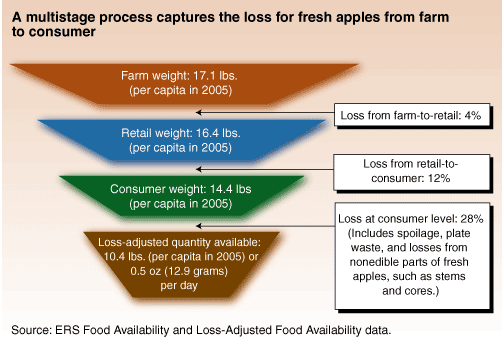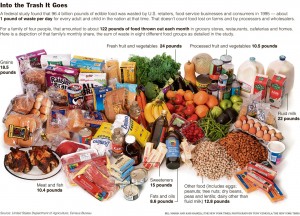We waste about 20-25% of all food purchased for the home. Wasting so much food has major consequences for our own and others’ health, including the health of the planet.
++++
Go to the grocery store and pick up 5 bags of groceries. Then go ahead and take one bag directly to the dumpster.
Umm… what?
Yep, we waste about 20-25% of all food purchased for the home. This equates to about 1.3 pounds of food tossed every day, or 474.5 pounds per year.
Wasting so much food has major consequences for our own and others’ health — including the health of the planet.
“There is a Buddhist concept known as mottainai, which encourages… us to be grateful for the resources we have, to be respectful of them and use them with care. It also calls for us not to waste.” –Nobel Laureate Wangari Maathai
What is food waste?
In the developed world, food is treated as a disposable commodity.
While none of us think directly destroying a rainforest is a good idea, throwing away food contributes to just that. If prosperous nations didn’t waste so much food, we could lighten pressure on the world’s remaining natural ecosystems.
Food losses occur through the food systemSome food losses occur at the farm and farm-to-retail level… |
|
Farm and post-harvest
|
Processing and wholesaling
|
| Source: Kantor LS, et al. Estimating and Addressing America’s Food Losses. Jan-Apr 1997 | |
Food waste is generally a product of food surplus. Throughout history, humans have disregarded sustainable use of resources when those resources were abundant.
The U.S. has the greatest food surplus of any nation. We have 200% of the energy requirements for an average adult — between 3,500 and 3,900 kcal are available per person. This is more than the average adult requires. Experts suggest that a 130% surplus is enough, which would be about 2,700 kcal for most adults.
So what are we doing with the excess?
We can store it, consume it, or waste it. And we can only store surplus for so long until we must waste it. Today, rich countries channel surplus food supplies into farm animals, trash cans and their own overfat bodies.
Food waste slide show gallery from The Guardian – check out all 18 images.
Why is food waste so important?
There’s a lot of it
In the U.S., where there is a significant food surplus, between 25% and 50% of all food is wasted (depending on sources & estimates).
If 5% of this was recovered, it would represent one day’s worth of food to 4 million people. If 25% was recovered, we are talking enough food to feed 20 million people – that’s the population of Sri Lanka.

Food waste per person is up 50% since 1974. That’s 1400 calories of food discarded per person each day.
Similarly, in Britain about 20 million tonnes of food waste are created each year.
Other people are hungry
The paradox is that worldwide food insecurity is at an all time high, with nearly 1 billion people hungry. Food prices continue to skyrocket in many regions, and even in affluent North America, there are record numbers of food bank users.
Food waste is unnecessary
40-50% of all food ready for harvest never gets eaten. It might be damaged in transit, discarded due to appearance, not sold at the store, or not eaten at home. If some foods don’t have a certain appearance – including size, shape and color, they are thrown away. So a perfectly good apple might get thrown out because it has a little spot on it.
Fruits and vegetables constitute 28% of this waste from retailers and consumers.

Food waste costs money
Food waste costs the U.S. $48 billion dollars each year.
Below: You think this is ridiculous? These stats are from 1995. We’ve gotten worse…
Food waste = wasting other resources
When we buy more food than we are going to eat, the developed world obliterates land and resources that could otherwise be used to feed the worlds deprived. Here’s what else we waste:
- Water: Experts estimate that food waste now accounts for more than one quarter of the total freshwater consumption. Wow. The current rate of wasted food in the world represents a loss of water close to 675 trillion litres. That’s enough for the household needs of 9 billion people using 200 liters per day. For more about water wasting – see All About Drinking Water.
- Other food: 40 to 60% of all fish caught are thrown back. This is known as by-catch. Many of the fish are edible, but haven’t been successfully marketed. For more about fish waste – see All About Eating Seafood.
- Environmental health and fuel: Food waste consumes more than 300 million barrels of oil per year (4% of total U.S. oil consumption). After we throw out food, there are consequences to the environment – organic materials make their way to landfills, decompose, and produce methane – which is a greenhouse gas. About 33% of methane emissions in the U.S. come from landfills. Methane is 20 times more damaging to the environment than carbon dioxide. There is potential for this methane to be used as biogas.
Food waste = other social problems
When we buy food and waste it, this reduces overall supply and drives up food prices. This makes food less affordable for those who are poor and malnourished in other parts of the world. It also creates other problems, as the graphic below shows.
Going to the dogs: food waste and animal feed
Remember mad cow disease? This emerged because manufacturers were using leftover animals in livestock feed — essentially getting herbivores to cannibalize each other.
We raise an animal to eat its meat, but what about livers, kidneys, brains, tongue, feet, etc? For centuries people have found ways to use these products. But now in the affluent world, we use them as ingredients in pet or livestock food.
In the last 30 years, consumption of offal –the viscera and trimmings of a butchered animal often considered inedible by humans — is down by 50%. Essentially, we eat the bits of animals that we like, and toss the rest. News flash: chicken have more than skinless breasts.
Along with “excess” meat, nearly 40% of global grains are fed to farm animals (this is higher in the U.S.). This doesn’t include the other food animals consume.
Worldwide, we give more than 3 times more food to livestock than they give us back in the form of milk, meat, and eggs. Translation: Livestock lose 70% of the calories in the harvests fed to them.
We’re obviously not throwing the food away when it’s fed to farm animals, but it’s inefficient in a world with nearly 7 billion people. The first thing people would probably demand in a global democracy is getting rid of fattened livestock – simply because of this inefficiency.
Summary and recommendations
“There are nearly a billion malnourished people in the world, but all of them could be lifted out of hunger with less than a quarter of the food wasted in Europe and North America. In a globalised food system, where we are all buying food in the same international market place, that means we’re taking food out of the mouths of the poor.” –Tristram Stuart
When we address the oversupply of food in the U.S., we can also help to alleviate obesity and environmental burdens. Here are ways that you can get involved and help cut down food waste.
- Figure out the source of your food waste: Do you keep too much food around that goes bad? Should you simply buy less? Maybe that giant “bulk pack” isn’t such a great buy if you don’t actually consume it.
- Examine reuse opportunities: Can you cook the wilted fruits or veggies? (Blackened bananas are perfect for banana muffins, for instance.) Can you make a stew with a leftover stir fry? Can you give food scraps to animals? Can you donate leftovers to food banks or homeless individuals?
- Consider composting: Find out environmentally friendly ways of food disposal.
- Use a shopping list: Find out what you actually have at home. Use leftovers. Buy a small loaf of bread, or buy a big one and freeze what you don’t immediately use. Eat crust – it’s 10% of the loaf. If you don’t like crusts, don’t eat bread. Don’t peel vegetables unless you absolutely must.
- Treat “best by” and “use by” dates with skepticism: Use good judgment. “Sell by” dates can be ignored completely. Be smart with meat consumption – buy from sustainable farms, if at all. Make sure your fridge is between 36 and 40 degrees F (2-4 C).
- Parents: Teach your kids about respecting food and finishing meals. Serve what you actually plan on eating.
Extra credit
While hauling off “separate” food waste can sound like a hassle, consider these examples.
- The Portland International Airport found that it cost them about $82 to have one ton of trash hauled away. Food waste only costs them $48 per ton. They set up separate bins for food waste in 2008 and saved $5,600 in hauling fees alone.
- The University of Dayton got rid of trash cans in their dining halls. Simply getting rid of food trays in college dining halls has cut food waste by about 38% – since people take less and eat what they take.
When we throw away a single ready-to-eat salad, we forfeit the complete upstream environmental footprint required to produce and deliver that item.
Officials in India complained that not only do Americans eat too much — if they slimmed down to the weight of middle-class Indians, said one, “many people in sub-Saharan Africa would find food on their plate.”
Remember crop gleaning? Some people are back at it: The need to feed hungry families cultivates new interest in gleaning. Also see Not Far From the Tree, an organization in Toronto that gleans surplus fruit from local trees right downtown.
Right now, the U.S. redistributes enough food to feed 26 million people.
“Now food television has a lot of shows about chefs doing fancy things with nice dishes. People think that is what chefs do. But that is not everything. There are lots of things that are not fancy… [Some cooks] waste food. They throw it in the garbage because they don’t know how to cook parts of it, or because they forgot about it in the fridge. They don’t appreciate the ingredients or the process. But vegetables and animals, they are born to be eaten by someone. That is the end of their lives. We have a responsibility to use the whole thing. We have to understand this destiny. A chef in the kitchen has to think very seriously about the food.”
–Chef Daisuke Izutsu of Kaiseki Sakura
References
Click here to view the information sources referenced in this article.
Learn more
Want to get in the best shape of your life, and stay that way for good? Check out the following 5-day body transformation courses.
The best part? They're totally free.
To check out the free courses, just click one of the links below.







Share